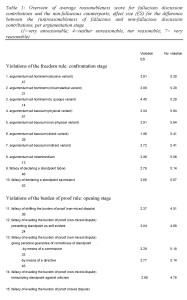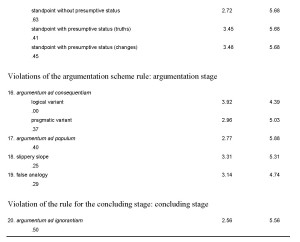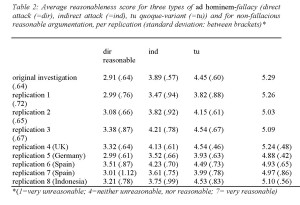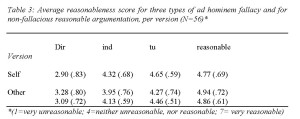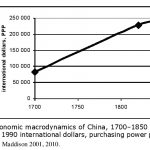ISSA Proceedings 2010 – The Extended Pragma-Dialectical Argumentation Theory Empirically Interpreted
No comments yet 1. The analytical status of the notion of ‘strategic maneuvering’
1. The analytical status of the notion of ‘strategic maneuvering’
The notion of strategic maneuvering, introduced by van Eemeren and Houtlosser, is basically an analytic concept enabling a more refined, accurate and comprehensive account of ‘argumentative reality’ than can be achieved by means of the existing, purely dialectical tools of canonical, standard pragma-dialectics (van Eemeren & Houtlosser, 1999b, 2000, 2002a, 2000b; van Eemeren, 2010). With the help of the notion of strategic maneuvering it becomes possible to reconstruct argumentative discourse as it occurs in practice in such a way that not only the dialectical dimension pertaining to its reasonableness is taken into account, but also the rhetorical dimension pertaining to its effectiveness (van Eemeren, 2010). In sum, in the extended pragma-dialectical approach incorporating the theory of strategic maneuvering the standard analysis of argumentative discourse is systematically enriched with the use of rhetorical insight.
The extended pragma-dialectical argumentation theory in which classical and modern rhetorical insights are integrated in the existing pragma-dialectical tools for reconstruction – i.e. resolution-oriented reconstruction – offers in the first place analytical instruments for analysing and evaluating argumentative discourse. It is not an empirical model of the various ways in which ordinary arguers try to achieve effective persuasion within the boundaries of dialectical rationality.[i]
Argumentative discourse can only be critically evaluated in a theoretically justified way if the discourse has first been adequately analysed. Starting from the pragma-dialectical point of departure, the analysis of argumentative discourse can be envisioned as a methodical reconstruction of the process of resolving the difference of opinion contained in the discourse. Using the extended theory taking account of strategic maneuvering as an analytical instrument for analysis and evaluation is to lead to an analytical overview attuned to enabling a sound critical evaluation. The ideal model of a critical discussion can serve as a heuristic instrument for reconstructing argumentative discourse in such a way that it becomes clear which function the various speech acts performed in the discourse fulfil and which commitments they create.
In a reconstruction of a discourse as a manifestation of a critical discussion it is assumed that the arguers aim to resolve their dispute on the merits. At the same time, however, it may be assumed that they will be intent on having their own standpoints accepted. This means that on the one hand they have to observe the dialectical obligations that have to do with the argumentative procedures that further an abstract ideal of reasonableness in critical discussion while on the other hand they have aims and considerations that are to be understood rhetorically in terms of effectiveness (also referred to as persuasiveness). Attempting to resolve a difference of opinion and at the same time trying to do so in one’s own favor creates a potential tension between pursuing dialectical objectives and rhetorical, persuasive aims. It is precisely this potential tension that gives rise to what van Eemeren and Houtlosser have coined strategic maneuvering, which is aimed at making the strongest possible case while at the same time avoiding moves that are clearly unreasonable.
In argumentative discourse, whether it takes place orally or in writing, it is generally not the arguer’s sole aim to win the discussion, but also to conduct the discussion in a way that is considered reasonable […] In their efforts to reconcile the simultaneous pursuit of these two different aims, which may at times even seem to go against each other, the arguers make use of what we have termed strategic maneuvering. This strategic maneuvering is directed at diminishing the potential tension between pursuing at the same time a ‘dialectical’ as well as a ‘rhetorical’ aim (van Eemeren & Houtlosser, 2002b: 135).
In a great many cases, the maneuvering, whether it is successful or not, is in perfect agreement with the rules for critical discussion and may count as acting reasonably. As a rule, strategic maneuvering is at least aimed at avoiding an open violation of these critical standards. Even arguers who momentarily let the aim of getting their own position accepted prevail will strongly attempt to keep up the appearance of being committed to the critical ideal of reasonableness (van Eemeren & Houtlosser, 2002: 16).
Much more could be said about this view of strategic maneuvering, but this short overview (and the references that are given) may suffice to show that one could easily be misled by interpreting the analytical model involved as an empirical-psychological one, as a model that aims to describe the argumentative behavior of ordinary arguers and their intentional, persuasive goals in ordinary real-life discussions. As said before, the analytical model for dealing with strategic maneuvering is definitely not an empirical model. One of the consequences of the specific analytical character of the model is that it cannot simply be put to a critical empirical test, at least not in a strict sense: empirical data are not able to falsify this model, nor are they able to confirm it – unless one is willing to add certain psychological or sociological assumptions to the model which are empirical by their very nature. But this does not mean that, seen from an empirical point of view, this model is useless: even if the model cannot be empirically tested in a strict sense, it is easy to see that it can function as a source for the derivation of theoretically motivated hypotheses about the argumentative behavior and persuasive goals of arguers in ordinary argumentative practice. And that is precisely the way in which this model will be used in this paper.
2. Three predictions
Three rather straightforward and plausible predictions can be derived from the notion of strategic maneuvering if this concept is interpreted empirically:
(1) Ordinary arguers are, at least to a certain extent, aware of their dialectical obligations; they know, at least at a pre-theoretical level, which contributions to the discussion are in accordance with the rules for critical discussion and are thus to be regarded as reasonable, and which contributions have to be considered as violations of these dialectical rules, in other words: which moves are fallacious and thus unreasonable. If ordinary arguers would lack such specific knowledge of the boundaries of the dialectical framework, there would be no reason at all for them to maneuver in a strategic sense – in that case they could go all out for rhetorical effectiveness, pursuing only and exclusively their own personal persuasive aims without taking into account the obligations dictated by the dialectical framework.
(2) Ordinary arguers assume that the other party in the discussion commit themselves to the same kind of dialectical obligations as they themselves do. If these jointly shared expectations (the protagonist knows… (…) and the protagonist knows that the antagonist knows… (…)) would not be in force in ordinary discussions, there would again be no reason for them to maneuver strategically. Expressed differently, ordinary arguers assume their interlocutors to apply similar norms and criteria for the evaluation of the reasonableness of discussion contributions as they themselves do, and regard ‘overt’ fallacies equally unreasonable as they do.
(3) Ordinary arguers assume – and assume that their interlocutors assume – that discussion contributions that violate the norms incorporated in the rules for critical discussion are unreasonable and that interlocutors who violate these commonly shared rules can be held accountable for being unreasonable. Consequently, the notion of ‘reasonableness’ is not only perceived by ordinary arguers in a merely (“descriptively”) normative sense, but also (and for the most part) in a prescriptive sense. Again, if this condition would not be met, there would be no reason for the discussion parties to maneuver strategically.
3. Prediction 1
3.1. Method prediction 1
During the past years we collected a mass of empirical data that are relevant for testing the first claim. In 1995, we started a comprehensive empirical project entitled Conceptions of Reasonableness that was completed in 2008 (for a detailed overview, see van Eemeren, Garssen & Meuffels, 2009). The aim of this project was to determine empirically which norms ordinary arguers use (or claim to use) when evaluating argumentative discourse, and to what extent these norms are in agreement with the critical theoretical norms of the pragma-dialectical theory of argumentation. Expressed differently: the aim of this ten-year project was to investigate and to test the conventional validity of the pragma-dialectical discussion rules: can it be expected that in actual discussion the rules are intersubjectively approved by the parties involved in a difference of opinion? The problem validity of the pragma-dialectical rules (are the rules instrumental in resolving a difference of opinion?) is primarily a theoretical issue. In contradistinction, the conventional validity of these rules can only be established by means of empirical research.
We carried out some 50 independent experiments, investigating the (un)reasonableness of 24 different types of fallacies. The setup of the experiments, the design of which we will report here, was in all cases the same: a repeated measurement design, combined with a multiple message design. That means that a variety of discussion fragments, short dialogues between two interlocutors A and B, were presented to the participants. (1) is an example of such a discussion fragment in which the abusive variant of the ad hominem fallacy is committed, (2) an example of the circumstantial variant, and (3) an example of the tu quoque-variant.
(1) (abusive variant; direct attack)
A: I think a Ford simply drives better; it shoots across the road.
B: How would you know? You don’t know the first thing about cars.
(2) (circumstantial variant; indirect attack)
A: In my view, the best company for improving the dikes is Stelcom Ltd; they are the only contractor in the Netherlands that can handle such an enormous job.
B: Do you really think that we shall believe you? Surely, it is no coincidence that you recommend this company: It is owned by your father-in-law.
(3) (tu quoque-variant; you too variant)
A: I believe the way in which you processed your data statistically is not entirely correct; you should have expressed the figures in percentages.
B: You’re not being serious! Your own statistics are not up to the mark either.
For baseline and comparison purposes, the participants also had to judge the (un)reasonableness of fragments in which no violation of a pragma-dialectical rule was committed:
(4) (no violation of the freedom rule)
A: I believe my scientific integrity to be impeccable; my research has always been honest and sound.
B: Do you really want us to believe you? You have already been caught twice tampering with your research results.
In all cases in the discussion fragments non-loaded topics were discussed, and in all cases paradigmatic, clear-cut cases of the fallacies were constructed. All fragments were put in a certain context. For instance, fragment (1) was presented in a domestic discussion context, fragment (2) in a political context, and fragment (3) and (4) in the context of a scientific debate. The participants were invariably asked to judge the reasonableness of the last contribution to the discussion, i.e. the contribution of B in the examples above. The participants had to indicate their judgment on a 7-point Likert scale, ranging from very unreasonable (=1) to very reasonable (=7).
3.2. Results prediction 1
First, we tested the conventional validity of the rule for the confrontation stage (the Freedom Rule) by investigating the (un)reasonableness of the three variants of the ad hominem fallacy, various variants of the argumentum ad baculum, the argumentum ad misericordiam, and the fallacy of declaring a standpoint taboo or sacrosanct (see Table 1 a + b).
Table 1: Overview of average reasonableness score for fallacious discussion contributions and the non-fallacious counterparts; effect size (ES) for the difference between the (un)reasonableness of fallacious and non-fallacious discussion contributions, per argumentation stage – (1=very unreasonable; 4=neither unreasonable, nor reasonable; 7= very reasonable)
Second, we tested the validity of the rule for the opening stage (the Burden of Proof Rule) by investigating the (un)reasonableness of, among others, the fallacy of shifting the burden of proof and the fallacy of evading the burden of proof in a non-mixed and in a mixed dispute. Third, we tested one of the pragma-dialectical rules for the argumentation stage (in this case rule number 8, the Argument Scheme Rule) by investigating the (un)reasonableness of the argumentum ad consequentiam, the argumentum ad populum, slippery slope and false analogy. And last, we tested the conventional validity of the rule for the final stage in a critical discussion (the concluding stage), by investigating the (un)reasonableness of the argumentum ad ignorantiam.
From the data presented in Table 1(a + b) it is clear that – with the notable exception of the logical variant of the argumentum ad consequentiam – the participants in our experiments made a clear distinction between the unreasonableness of discussion moves that, according to pragma-dialectical standards, involve a fallacy and those that are not fallacious: fallacious discussion moves are considered unreasonable by ordinary arguers, while non-fallacious moves are judged as reasonable.[ii] These results can be taken as a strong support for our first prediction: ordinary arguers are to a large extent aware of what the dialectical obligations in an argumentative discussion entail.[iii]
4.Prediction 2
Methodological considerations
In contrast with the mass of empirical data we have collected in order to test the conventional validity of the pragma-dialectical discussion rules, only one single experiment is conducted in which we tested our second prediction that could be derived from the extended model incorporating strategic maneuvering. This prediction pertains to the reciprocal social expectations of discussion parties regarding the commitment to dialectical discussion rules: ordinary arguers assume that the other party in the discussion commit themselves to the same kind of dialectical obligations as they themselves do. As for testing this second prediction (and, by the way, also the third prediction), we will make use again of the empirical results obtained in the project Conceptions of Reasonableness.
In the project Conceptions of Reasonableness the three variants of the ad hominem-fallacy are investigated frequently, not only in the Netherlands but also in countries abroad (see Table 2). As a consequence, we have now insights into (1) the stability of the reasonableness data for the three types of fallacy, (2) the ordinal reasonableness relations of the three types of fallacy, and (3) the absolute reasonableness assessments of the three types of fallacy. Based upon these insights, different specific predictions can be inferred for experiment 2 (and also for experiment 3). First, from the consistent results shown in Table 2 it is clear that the ordinal relations between the rated reasonableness of the three types of ad hominem-fallacy in the original main investigation and in the replications of this investigation are identical: the direct attack is invariably judged as the least reasonable move, next the circumstantial variant, and lastly the tu quoque-variant. Second, the tu quoque variant tends to be judged as a reasonable move, provided we abstract from the specific contexts in which this fallacy was offered to the participants. Third, in line with the results reported in Table 1 it is evident that invariably those non-fallacious, reasonable discussions contributions are (in a statistically significant sense) considered as more reasonable than the fallacious moves in which an argumentum ad hominem is committed.
Table 2: Average reasonableness score for three types of ad hominem-fallacy (direct attack (=dir), indirect attack (=ind), tu quoque-variant (=tu)) and for non-fallacious reasonable argumentation, per replication (standard deviation: between brackets)* *(1=very unreasonable; 4=neither unreasonable, nor reasonable; 7= very reasonable)
In our investigation of prediction 2 we exposed our participants to instantiations of the three types of ad hominem-fallacy and instantiations of non-fallacious moves, and we requested them to rate the (un)reasonableness of these discussion fragments (i.e. the last contribution) according to their own insights and judgment – as was the case in all our experiments conducted within the framework of the project Conceptions of Reasonableness; in addition to that, they had to rate similar fallacious and non-fallacious fragments, but this time with the instruction to indicate how reasonable or unreasonable they think and expect that relevant others would judge these fragments. Prediction 2 can be considered to be confirmed if the three above mentioned stable patterns of Table 2 show up again, not only in the condition in which the participants have to rate the fragments according to their own insight but equally well in the condition in which they have to make an estimation of the judgment of relevant others. Any difference between both conditions as a (statistical) main effect (or an interaction between ‘condition’ and ‘type of fallacy’) would be disastrous for the confirmation of prediction 2.
4.1. Method prediction 2
In order to test prediction 2, 48 discussion fragments were constructed: short dialogues between two discussants (called A and B) in which the antagonist B violated 36 times the pragma-dialectical rule for the confrontation stage by means of one of the three variants of the argumentum ad hominem. In 12 discussion fragments no discussion rule was violated; in those fragments B adduced only non-fallacious, reasonable argumentation.
Two versions were constructed: version ‘Self’ and version ‘Other’, both consisting of 24 discussion fragments; the fragments in each version were randomly drawn from the whole set of 48 fragments and subsequently quasi-randomly assigned to one of the two versions, such that both versions contained precisely the same number of instantiations of the same type of fallacy. Consequently, both in the version Self and in the version Other the direct attack, the indirect attack and the tu quoque-variant are each represented by 6 instantiations. The design in this experiment can thus characteristically be regarded as a multiple message design (examples of concrete messages presented to the participants are shown in Section 3).
56 pupils of the fourth and fifth year of secondary school (most of them 16 and 17 years old respectively) participated in the experiment; none of them had ever had any specific argumentation teaching. After each discussion fragment in the version Self the question that is asked is “How reasonable or unreasonable do you (yourself) think B’s reaction is?”, and in the version Other the question that is asked is “How reasonable or unreasonable do you think relevant others would judge B’s reaction?” (relevant others were in the instruction described as friends or relatives). In both versions they could indicate their judgment on a 7-point scale, ranging from 1 ‘very unreasonable’ (=1) to ‘very reasonable’ (=7). The order of presentation of the two versions was randomized over the subjects; half of the participants had first to fill in the version Self and subsequently the version Other, the other half of the participants received the reversed order (as there were no statistical significant differences between the two orders, we will abstract from this variable). As all the participants were exposed to all levels of both the independent variable ‘version’ and the independent variable ‘fallacy/no fallacy’, the chosen design can also be described as a repeated measurement design.
4.2. Results prediction 2
The data in Table 3 were analyzed by means of a multivariate analysis of variance (‘mixed model’ approach for repeated measurements, with ‘subject’ and ‘instantiation’ as random factors and the variables ‘version’ and ‘type of fallacy’ as fixed factors; the random factor ‘instantiation’ is nested within the interaction of the fixed factors ‘version’ and ‘type of fallacy’, whereas the random factor ‘subject’ is fully crossed with the random factor ‘instantiation’ and the fixed factors ‘version’ and ‘type of fallacy’; the statistical consequence of this rather complicated design is that – instead of ordinary F-ratio’s – quasi F-ratio’s have to be computed, while the degrees of freedom have to be approximated).
From the data in Table 3 it is evident that the well known ordinal pattern in reasonableness relations between the three types of ad hominem fallacies crop up again in this experiment, regardless of the type of condition (version). No matter whether the participants have to base their reasonableness ratings on their own judgment or whether they have to estimate the verdict regarding the unreasonableness of the three variants of the ad hominem fallacy of relevant others, the direct attack is invariably judged as the most unreasonable move, next the indirect attack and subsequently the tu quoque-variant. And precisely as was the case in the investigations presented in Table 2, again the tu quoque-variant tends to be considered as a reasonable discussion move.
Table 3: Average reasonableness score for three types of ad hominem fallacy and for non-fallacious reasonable argumentation, per version (N=56)*
*(1=very unreasonable; 4=neither unreasonable, nor reasonable; 7= very reasonable)
So far as the differences in reasonableness between non-fallacious reasonable argumentation on the one side and fallacious argumentation on the other side are concerned, there are no statistically significant differences between the version Self and the version Other. In both conditions reasonable argumentation is regarded (in an absolute sense) as reasonable, while in both conditions the direct attack and the indirect attack are considered as significantly less reasonable than non-fallacious argumentation (contrast direct attack vs. reasonable argumentation F(1,42)=84.46; p<0.001; ES=0.31; contrast indirect attack vs. reasonable argumentation F(1,28)=12.51; p<0.001; ES=0.07). However, both in the condition Self and in the condition Other our subjects do not discriminate between the (un)reasonableness of the tu quoque-variant and the (un)reasonableness of reasonable argumentation: F (1, 23) =2.60; n.s.).
At least as important for the confirmation of prediction 2 is our finding that there is no statistical significant (main) effect of the independent variable ‘condition’ in case of the three relevant contrasts between (1) the direct attack and reasonable argumentation: F(1,32)=3.81; n.s., (2) the indirect attack and reasonable argumentation: F(1,25)=.35; n.s., and the tu quoque-variant and reasonable argumentation: F(1,25)=.24; n.s., nor a statistically significant interaction between the independent variables ‘condition’ and ‘fallacy/no fallacy’ (direct attack: F(1,25)=.41; n.s.; indirect attack: F(1,27)=1.72; n.s.; tu quoque-variant: F(1,23)=1.17; n.s.).
All these results point in the same direction: ordinary arguers expect others to judge the (un)reasonableness of fallacious and non-fallacious discussion contributions in a similar way as they themselves do.
5. Prediction 3
5.1. Method prediction 3
For testing prediction 3 (ordinary arguers assume – and assume that their interlocutors assume – that discussants who violate the commonly shared rules for critical discussion are unreasonable and can be reproached for being unreasonable; consequently, the notion of ‘reasonableness’ is by ordinary arguers not only used in a mere (“descriptive”) normative sense, but also and for the most part in a prescriptive sense) we will make use again of our consistent findings in the project Conceptions of Reasonableness: once again the three variants of the ad hominem fallacy were presented to the participants, but this time the discussion fragments did not have to be judged on reasonableness but they had to be rated according to the extent that the antagonist is violating a norm in his (last) contribution to the discussion.
59 subjects (18-19 years old pupils) participated in this experiment. Similar discussion fragments were presented to them as in the previous experiment. In 12 of the 48 fragments the fallacy of the direct attack was committed, in 12 fragments the indirect attack, in 12 fragments the tu quoque-variant and in the remaining 12 fragments reasonable argumentation was used. This time the reaction of antagonist B had to be judged on a 7-point, scale ranging from ‘absolutely violating a norm’ (=1) to ‘not at all norm-violating’ (=7). The design of this experiment is the same as in the previous experiment: a repeated measurement design, combined with a multiple message design.
5.2. Results prediction 3
In Table 4 the results are reported.
Table 4: Average scores for the extent of norm violation for three types of ad hominem fallacy and for non-fallacious reasonable argumentation (N=59)*
*(1=absolutely violating a norm; 7= not at all norm-violating)
The familiar patterns, derived from Table 2, are again present in Table 4: the direct attack is judged as the most norm-violating move, next the indirect attack, and finally the tu quoque-variant; this last variant is considered as a discussion move that tends to be the qualified as ‘no norm violating’. As expected, the non-fallacious discussion contributions are rated as moves that can be regarded as non-norm-violating.Each of the three ad hominem fallacies is judged in a statistically significant sense as more rule violating compared with non-fallacious reasonable argumentation. This holds even in the case of the tu quoque variant (direct attack: F(1,72)=65.73; p<0.000; ES=.27; indirect attack: F(1,58)=31.80; p<0.000; ES=.13; tu quoque variant: F(1,28)=6.03; p<0.02; ES=.04). Nor surprisingly in light of the data in Table 2, there are big differences between the three types of fallacies regarding the extent to which they are regarded as norm-violating (F (2, 57) =15.03; p<0.000; ES= .11). According to the judgment of our participants, in case of the direct attack norms are much more violated compared with the other two types of fallacy (F(1,57)=23.41; p<0.001); the indirect attack in turn is considered as a more norm-violating move than the tu quoque variant (F(1,57)=5.92; p<0.02).
In sum, discussion moves that are considered as unreasonable by our participants (moves that are also unreasonable in a theoretical sense according to the pragma-dialectical standards) are judged as norm-violating, while moves that are assessed as reasonable by our participants (moves that are also reasonable in a theoretical sense) are considered as not norm-violating.
6. Conclusion
The paradigmatic division between dialectical and rhetorical approaches to argumentative discourse can be bridged by introducing the theoretical concept of strategic maneuvering, as proposed in the extended pragma-dialectical theory of argumentation. This makes it possible to integrate rhetorical insights into a dialectical framework of analysis. Strategic maneuvering refers to the deliberate efforts arguers make to reconcile their aiming for rhetorical effectiveness with maintaining dialectical standards of reasonableness. If one interprets this analytical model in an empirical sense, three rather vital claims can be derived. We have shown in this article that these claims are strongly supported by the results of our experiments. (1) Ordinary arguers are, at least to a certain extent, aware of their dialectical obligations; they know, at least at a pre-theoretical level, which contributions to the discussion are in accordance with the rules for critical discussion and are thus to be regarded as reasonable, and which contributions have to be considered as violations of these dialectical rules, in other words: which moves are fallacious and thus unreasonable. (2) Ordinary arguers assume that the other party in the discussion commit themselves to the same kind of dialectical obligations as they themselves do. (3) Ordinary arguers assume – and assume that their interlocutors assume – that discussion contributions that violate the norms incorporated in the rules for critical discussion are unreasonable and that interlocutors who violate these commonly shared rules can be held accountable for being unreasonable.
NOTES
[i] For our use of the terms effectiveness and persuasiveness and our use of the terms rationality and reasonableness, see van Eemeren, 2010: 39 and 29, respectively.
[ii] With the exception of the logical variant of the ad consequentiam fallacy, all differences in reasonableness between a particular fallacy and its non-fallacious counterpart are statistically significant – ordinary arguers not very often regard the reductio ad absurdum as a type of sound argumentation, just as they hardly see that the fallacy that copies this sound argumentation (namely the logical variant of the argumentum ad consequentiam) is an obvious fallacy. In some cases in Table 1 no effect size is reported – in those cases ES could not be computed, due to the specific characteristics of the chosen design. Moreover, from the data presented in Table 1 (and equally in Table 2) one may not infer that fallacies such as the tu quoque-variant are regarded as reasonable moves. In Table 1 we abstracted from the specific discussion context in which the fallacies were offered to the participants, but in a scientific discussion context the tu quoque fallacy is invariably judged as an unreasonable move.
[iii] Notice that there is an enormous range in the judged unreasonableness of the various fallacies: the physical variant of the argumentum ad baculum, for example, is regarded as an absolute unreasonable move, while the tu quoque variant of the ad hominem fallacy tends to be considered as a reasonable move (provided we abstract from the specific discussion contexts in which this fallacy was presented). Such data make sense: threatening the other party in the discussion with brute physical violence is the example par excellence of irrational, unreasonable behavior, while committing a tu quoque fallacy has at least in some discussion contexts the appearance of being reasonable. Serious participants in a conversation may be expected to show some consistency between their (past and present) words and deeds.
REFERENCES
Eemeren, F.H. van (2010). Strategic Maneuvering in Argumentative Discourse. Extending the Pragma-Dialectical Theory of Argumentation. Amsterdam/Philadelphia: John Benjamins.
Eemeren, F.H. van, Garssen, B., & Meuffels, B. (2009). Fallacies and Judgments of Reasonableness. Empirical Research Concerning the Pragma-Dialectical Discussion Rules. Springer: Dordrecht.
Eemeren, F.H. van, & Houtlosser, P. (1999). Strategic manoeuvring in argumentative discussions. Discourse Studies, 1(4), 479-497.
Eemeren, F.H. van, & Houtlosser, P. (2002a). And always the twain shall meet. In F.H. van Eemeren & P. Houtlosser (Eds.), Dialectic and Rhetoric: The Warp and Woof of Argumentation Analysis (pp. 3-11). Dordrecht: Kluwer.
Eemeren, F.H. van, & Houtlosser, P. (2002b). Strategic maneuvering: Maintaining a delicate balance. In F.H. van Eemeren & P. Houtlosser (Eds.), Dialectic and Rhetoric: The Warp and Woof of Argumentation Analysis (pp. 131-159). Dordrecht: Kluwer.
You May Also Like
Comments
Leave a Reply
